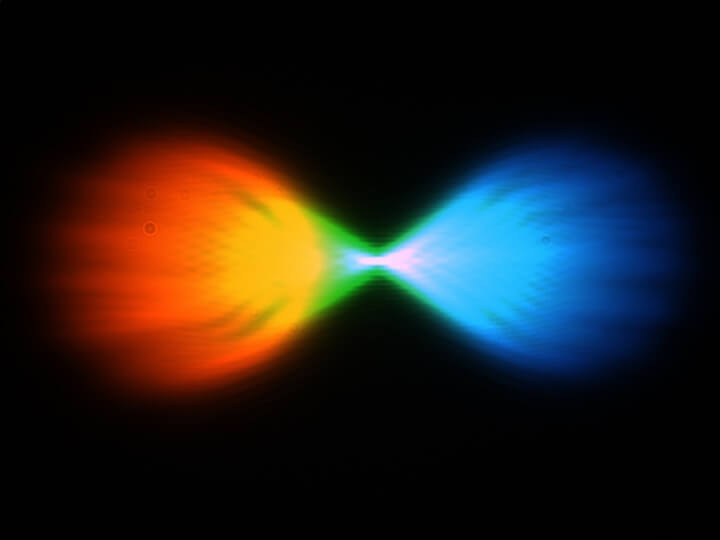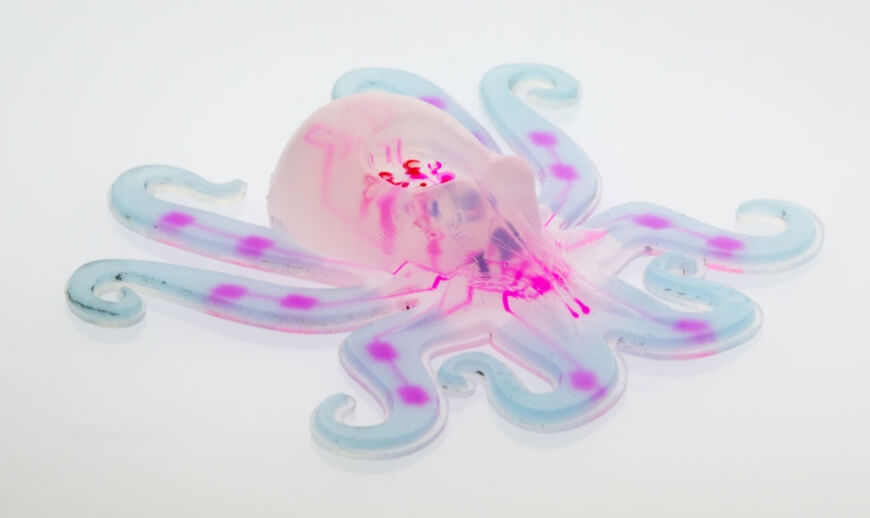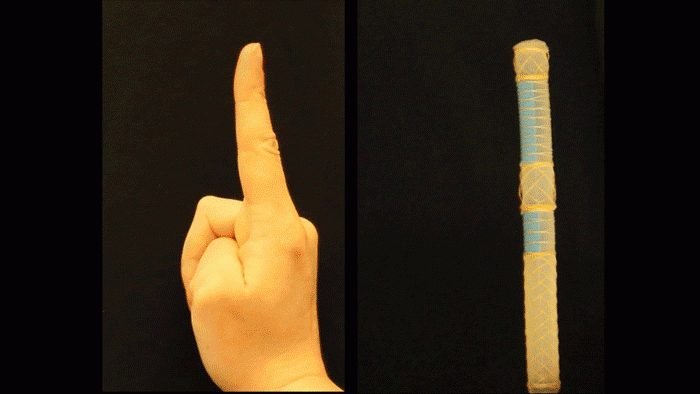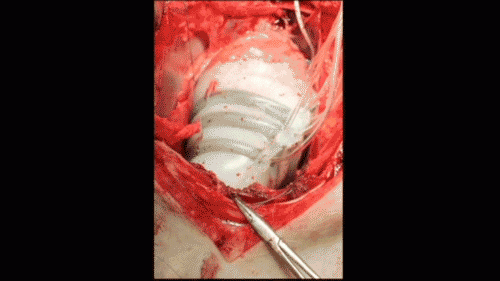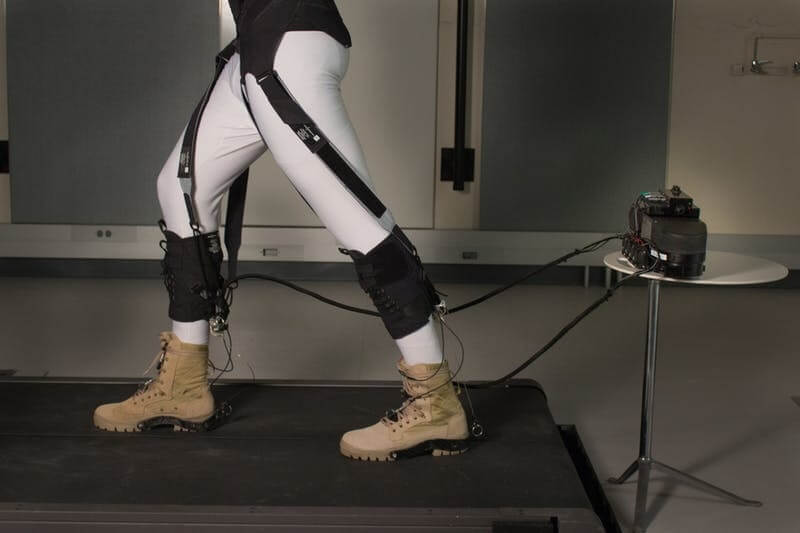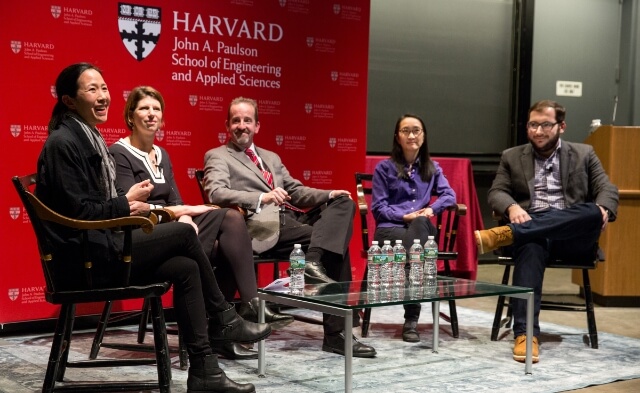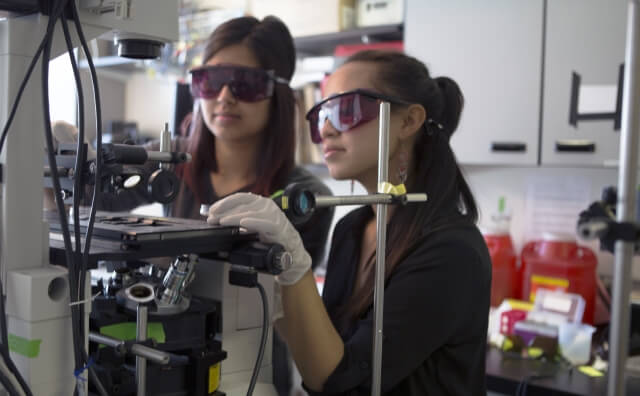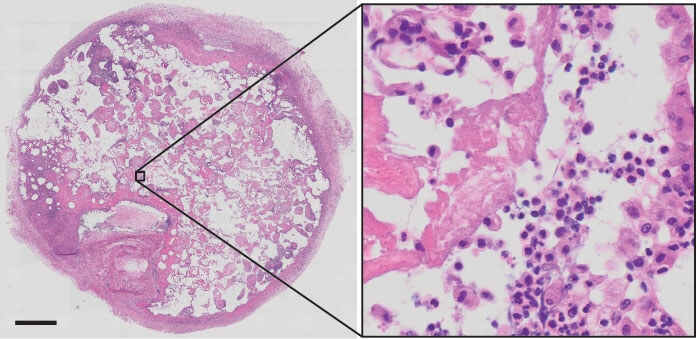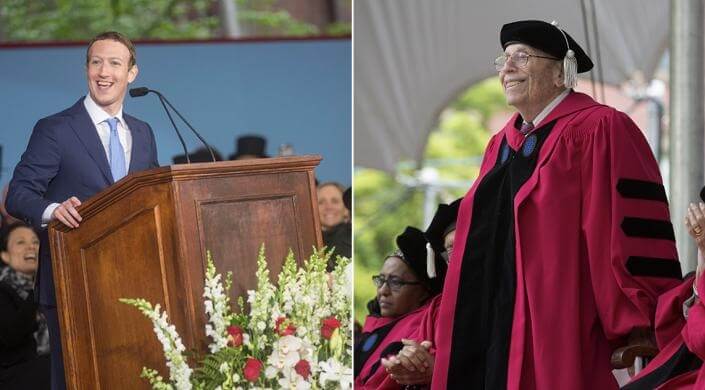News
Through teaching and collaborative research, SEAS discovers, designs, and creates novel technologies and approaches to societal challenges—in service to the world, the nation, and our community. We bridge disciplines, both within engineering and the applied sciences and beyond, to prepare broadly trained leaders, to advance foundational science, and to achieve translational impact. Highlights from a year of innovative teaching, breakthrough research, inventive student projects, and global impact.
Image of optical fiber (pumped with broadband light) formed by Multispectral Chiral (MCHL) (Courtesy of the Capasso Lab/Harvard SEAS)
June 2016
The lab of Federico Capasso, the Robert L. Wallace Professor of Applied Physics and the Vinton Hayes Senior Research Fellow in Electrical Engineering, developed an ultra-thin planar lens that could replace heavy, bulky lenses in smart phones, cameras, and telescopes.
David Clarke, the Extended Tarr Family Professor of Materials, and his graduate student, William Bonificio, developed a method to separate rare earth metals using bacteria filters and solutions with pH no lower than hydrochloric acid.
A SEAS student engineering project received NASA’s Undergraduate Student Instrument Project grant for their spectrometer that measures hydrochloric acid (HCl) in the atmosphere.
SEAS researchers changed liquid hydrogen to metallic hydrogen by recreating the extreme pressures and temperatures of Jupiter.
July 2016
SEAS researchers developed an artificial muscle for soft robotics, allowing for a broad range of motion that requires low voltage and no rigid components.
Harvard researchers identified a new class of high-performing organic molecules that can safely store electricity from intermittent energy sources like solar and wind power in large batteries. These molecules were inspired by vitamin B2.
The Harvard chapter of Engineers Without Borders, including several SEAS students, launched a long-term project to refurbish a Tanzanian elementary school to meet the needs of the growing community.
The octobot, here with fluorescently dyed fugitive inks (red) and hyperelastic actuator layers (blue), is fabricated by moulding and 3D printing. (Image courtesy of Lori Sanders/Harvard University)
August 2016
Robert Wood, the Charles River Professor of Engineering and Applied Sciences, and Jennifer A. Lewis, the Hansjorg Wyss Professor of Biologically Inspired Engineering, led a team of researchers to demonstrate the first autonomous, untethered, entirely soft robot. This small, 3D-printed robot—nicknamed the octobot—could pave the way for a new generation of completely soft, autonomous machines.
Brian Fountaine, a graphic designer and Army combat veteran, was artist-in-residence in the lab of Kit Parker, Tarr Family Professor of Bioengineering and Applied Physics, as part of the Research Experiences for Undergraduates program.
SEAS researchers designed more than 1,000 new blue-light emitting molecules for organic light-emitting diodes (OLEDs) that could dramatically improve displays for televisions, phones, tablets, and more.
Validere, cofounded by Harvard scientists and engineers, aims to develop Watermark Ink (W-Ink) into an inexpensive, instantaneous, and portable pocket-sized device that could be used to quickly identify chemical spills, or by officials to verify the fuel grade of gasoline right at the pump.
SEAS researchers, in collaboration with colleagues from Duke and Yale universities, developed a method to predict which metallic alloys may form a bulk metallic glass, which have the malleability of plastic, while retaining its durability and conductivity.
Harvard researchers developed a way to send mechanical signals through soft materials by using a chain of bistable elastomeric beams connected by elastomeric linear springs, which store energy in the form of elastic deformation as they deform and snap.
GJ 1132b similar to Earth in size and mass, and is relatively cool, about 450 degrees F, and could potentially host an atmosphere. (Image courtesy of Dana Berry / Skyworks Digital / CfA)
SEAS researchers, in collaboration with colleagues at Yale University, identified western U.S. counties with the highest risk of exposure to pollution from wildfires. They used a fire prediction model and advanced atmospheric modeling to separate pollution caused by wildfires from other pollution, and track the likely movement of smoke, coining the term ‘smoke wave’ to describe two or more days of unhealthy levels of fine particles from fires.
The Engineering Accreditation Commission of ABET, the global accreditor of engineering programs, accredited three Bachelor of Science (S.B.) degree programs—in Engineering Sciences, Electrical Engineering, and Mechanical Engineering at SEAS.
Harvard scientists determined that a Venus-like exoplanet may have an oxygen atmosphere, but it is unlikely to support life due to the intense heat.
As part of Harvard’s Public School Partnerships, SEAS’s “Science and Cooking for Kids” program taught Boston Public School children about science through experiments with chocolate and smoothies.
September 2016
Barbara Grosz, the Higgins Professor of Natural Sciences, contributed to the “Artificial Intelligence and Life in 2030” report from the One Hundred Year Study on Artificial Intelligence, which she chairs. The report examines how AI might affect urban life in the next 15 years.
A team of Harvard students and Peruvian students from Universidad de Ingeniería Y Tecnología (UTEC) was challenged to design tools that can clean the polluted river water that flows through Peru's Madre De Dios region. During the summer, the UTEC students worked in the lab of Chad Vecitis, Associate Professor of Environmental Engineering, to develop and test a gold dissolution method using iodine.
Six high school students worked on projects in the lab of Vahid Tarokh, the Perkins Professor of Applied Mathematics and the Vinton Hayes Senior Research Fellow of Electrical Engineering. Their summer projects included implementing an algorithm to build an evolutionary tree for bacteria, conducting time-series analysis of fluctuations in gold prices, and building sensory gloves to gather data on grasping motions.
SEAS researchers experimentally proved the decades-old theory that predicted with the right amount of tensile force, a thick cube of soft material would suddenly deform into a thin, flat plate. This instability allows for the creation of materials that can use this to change or enhance their functionality.
A team led by Joanna Aizenberg, the Amy Smith Berylson Professor of Materials Science and Professor of Chemistry & Chemical Biology, engineered a transparent surface coating for an endoscope lens that could effortlessly keep blood and other fluids at bay. This technology creates non-wetting and robust self-cleaning surfaces that can resist almost any fouling challenge a surface may face.
An environmental science and engineering concentrator used the Internet of Things to monitor temperature in Eliot House, seeking to conserve energy in the winter.
October 2016
The labs of Kit Parker, the Tarr Family Professor of Bioengineering and Applied Physics, and Jennifer Lewis, the Hansjorg Wyss Professor of Biologically Inspired Engineering, developed a technique to create fully functional, instrumented hearts-on-chips for drug screening and disease modeling. The chip contains multiple wells, each with separate tissues and integrated sensors, allowing researchers to study many engineered cardiac tissues at once.
In order to advance research on muscular dystrophy, a team of researchers led by Kit Parker, the Tarr Family Professor of Bioengineering and Applied Physics, developed a muscle-on-a-chip platform to study the disease. The platform led to a deeper understanding of how muscular dystrophy affects muscle formation and strength.
A HUBWeek session examined the rise of smart devices, and the accompanying loss of privacy. As part of the session, James Waldo, the Gordon McKay Professor of the Practice of Computer Science and chief technology officer at SEAS, raised concerns of ethics and data collection in a world of increasing connectivity.
Kit Parker’s Disease Biophysics Group, developed a new method to make and collect nanofibers and control their size and morphology. This could lead to stronger, more durable bulletproof vests and armor and more robust cellular scaffolding for tissue repair. Parker is the Tarr Family Professor of Bioengineering and Applied Physics at SEAS.
A team of Harvard scientists led by David Mooney, the Robert P. Pinkas Family Professor of Bioengineering, discovered a way to analyze how the stiffness of the extracellular material that surrounds cells and structures tissues affects a drug’s efficacy in a chemotherapy treatment.
Jennifer A. Lewis, the Hansjorg Wyss Professor of Biologically Inspired Engineering, led a team of Harvard scientists who bioprinted a tubular 3D renal architecture that recapitulates functions of the kidney.
SEAS researchers solved one of the main challenges to quantum computing: how to transmit spin information through superconducting materials.
November 2016
Members of the International Genetically Engineered Machine (iGEM) team at SEAS, used synthetic biology to tackle the problem of marine micro-plastic pollution. Their solution won a gold medal and was nominated for best environmental project in the undergraduate category at the annual iGEM competition, which included more than 300 student teams from dozens of nations.
In an effort to prevent deaths of infants and toddlers from heat stroke when left unattended in hot cars, two Harvard students developed a tech-driven car
Students Risham Dhillon (left) and Phoebe Stoye developed Chirp to help prevent infant deaths in hot cars. (Photo by Adam Zewe/SEAS Communications.)
seat alert system. Chirp, their startup, uses sensor technology and a mobile app to warn caregivers when babies are in danger of being left alone in car seats.
In a study led by Elsie Sunderland, the Thomas D. Cabot Associate Professor of Environmental Science and Engineering, Harvard researchers found that over 90 percent of potential new Canadian hydroelectric projects are likely to increase concentrations of the neurotoxin methylmercury in food webs near indigenous communities.
Researchers at SEAS, in collaboration with King Abdullah University of Science and Technology, developed a new, more robust, and cost effective system to build large-scale metamaterials with structural color, inspired by the arrays of nanofibers that produce colors in a bird’s feather.
Members of the Harvard student-driven Digital Literacy Project taught introductory computer science classes to seven local middle schools. The outreach model is unusual because the lessons are presented during the school day, like a traditional art or music class.
December 2016
Researchers used mathematical modeling to optimize the design of an actuator to perform biologically inspired motions.
Designing a soft robot to move organically—to bend like a finger or twist like a wrist—has always been a process of trial and error. A team of researchers led by Katia Bertoldi, the Gordon McKay Professor of Applied Mechanics, and Conor Walsh, the John L. Loeb Associate Professor of Engineering and Applied Sciences, developed a method to automatically design soft actuators based on the desired movement.
Researchers from SEAS made the world’s smallest radio receiver–built out of an assembly of atomic-scale defects in pink diamonds. The tiny radio can withstand extremely harsh environments and is biocompatible, meaning it could work anywhere from a probe on Venus to a pacemaker in a human heart. The research was led by Marko Loncar, the Tiantsai Lin Professor of Electrical Engineering.
One drastic idea to cool the planet without further damaging the ozone is solar engineering—injecting light-reflecting sulfate aerosols into the stratosphere to cool the planet. David Keith, the Gordon McKay Professor of Applied Physics at SEAS and Professor of Public Policy at the Harvard Kennedy School, and Frank Keutsch, the Stonington Professor of Engineering and Atmospheric Science at SEAS and Professor of Chemistry and Chemical Biology, led the research.
For their collaborative project in Engineering Problem Solving and Design (ES 96), SEAS students developed a wireless label printing system that streamlines and standardizes the process of tagging hazardous materials and wastes. They worked with the Office of Environmental Health and Safety in order solve the challenge of monitoring the enormous amount of chemicals that are stored, utilized, and disposed of in more than 600 laboratories.
During the 15th annual SEAS Holiday Lecture, Howard Stone, Dixon Professor in Mechanical and Aerospace Engineering at Princeton University, explained surface tension to hundreds of local children and their parents through a variety of interactive experiments to showcase the power of science.
January 2017
Harvard University and Boston Children’s Hospital researchers developed a customizable soft robot that fits around a heart and helps it beat, potentially
In vivo demonstration of cardiac assist in a porcine model of acute heart failure (Video courtesy of Ellen Rouche/Harvard SEAS)
opening new treatment options for people suffering from heart failure. Unlike currently available devices that assist heart function, Harvard’s soft robotic sleeve does not directly contact blood. This reduces the risk of clotting and eliminates the need for a patient to take potentially dangerous blood thinner medications.
ComputeFest 2017 tackled the future of the computational economy. Speakers encouraged attendees to be aware of how computer science intersects with other parts of society, especially law and government.
Harvard University researchers led by Kit Parker, the Tarr Family Professor of Bioengineering and Applied Physics, developed a multiregional brain-on-a-chip that models the connectivity between three distinct regions of the brain. The in vitro model was used to extensively characterize the differences between neurons from different regions of the brain and to mimic the system’s connectivity.
By isolating the beneficial effects of the soft exosuit, scientists can calculate the impact on the wearers’ joints. (Image courtesy of Wyss Institute at Harvard University)
A study led by Robin Wordsworth, Assistant Professor in Environmental Science and Engineering, found that interactions between methane, carbon dioxide, and hydrogen in the early Martian atmosphere may have created warm periods when the planet could support liquid water on the surface.
A multidisciplinary team led by Conor Walsh, the John L. Loeb Associate Professor of Engineering and Applied Sciences, isolated the beneficial effects of the soft exosuit to calculate the impact on the wearers’ joints.
SEAS researchers developed a general framework to design reconfigurable metamaterials. Metamaterials are materials whose function is determined by structure, not composition.
February 2017
Researchers from SEAS developed a new flow battery that stores energy in organic molecules dissolved in neutral pH water. This new chemistry allows for a non-toxic, non-corrosive battery with an exceptionally long lifetime and offers the potential to significantly decrease the costs of production.
SEAS researchers led by Federico Capasso, the Robert L. Wallace Professor of Applied Physics and the Vinton Hayes Senior Research Fellow in Electrical Engineering, developed the first flat lens that works within a continual bandwidth of colors, from blue to green. This bandwidth, close to that of an LED, paves the way for new applications in imaging, spectroscopy, and sensing.
Inspired by natural cellular structures, researchers at SEAS and MIT developed a new method to 3D print materials with independently tunable macro-and microscale porosity using a ceramic foam ink. Their approach could be used to fabricate lightweight structural materials, thermal insulation, or tissue scaffolds.
SEAS launched Humanity and Its Challenges: Systems Thinking and Engineering Design Solutions (ES 26) in Spring 2017. The course, co-taught by
Panelists (from left) Joanne Chang, A.B. '91, Julie Kitchenka Ferland, S.B. ’98, Dean Frank Doyle, Dao Nguyen, A.B. ’94, and Eric Hysen, A.B. '11, shared insights and advice with sophomores at the first annual Sophomore Convocation. (Photo by Lori K. Sanders/SEAS.)
Fawwaz Habbal, Executive Dean for Education and Research, Cherry Murray, the Benjamin Peirce Professor of Technology and Public Policy, and Vikram Mansharamani, Lecturer on Engineering Sciences, is designed to give students an appreciation of the complexities involved in some of the world’s most intractable problems and how a systems thinking approach is critical for developing effective solutions.
Enrollment began in clinical trials to provide the final tests for an artificial pancreas to automatically monitor and regulate blood-sugar levels in people with type 1 diabetes. The systems being tested are the result of collaboration between researchers at SEAS and the University of Virginia.
On Feb. 7, SEAS held the first-ever Sophomore Convocation to welcome new concentrators into the SEAS community.
SEAS researchers drew material inspiration from kirigami, the ancient Japanese paper craft that relies on cuts, rather than folds, to change the structure and function of materials. The researchers demonstrated how a thin, perforated sheet can be transformed into a foldable 3D structure by simply stretching the cut material.
March 2017
Research by Robin Wordsworth, Assistant Professor of Environmental Science and Engineering, and Francis Macdonald, the John L. Loeb Associate Professor of the Natural Sciences, suggested that a volcanic event started the Sturtian snowball Earth event.
The Disease Biophysics Group, based in the lab of Kit Parker, the Tarr Family Professor of Bioengineering and Applied Physics, developed a hand-held device that can quickly produce nanofibers with precise control over fiber orientation.
Cellino is a spinoff of the nanotechnology research being conducted in the Mazur lab. (Photo by Adam Zewe/SEAS Communications)
Two graduate students launched a startup to develop a simple, push-button device clinicians could use for gene therapy treatments. Their enterprise, Cellino, hopes to commercialize technology being developed in the lab of Eric Mazur, the Balkanski Professor of Physics and Applied Physics.
Researchers from SEAS developed a new method using gold microstructures to deliver a variety of molecules into cells with high efficiency and no lasting damage.
Using simple mathematical ideas, researchers from the lab of L. Mahadevan, the Lola England de Valpine Professor of Applied Mathematics, of Organismic and Evolutionary Biology, and of Physics, constructed a framework that explains and quantifies the different shapes of plant stems.
Harvard University launched the Data Science Initiative. The University-wide program will facilitate cross-disciplinary collaboration, and will be co-led by Francesca Dominici, Professor of Biostatistics at the Harvard T.H. Chan School of Public Health, and David C. Parkes, the George F. Colony Professor and Area Dean for Computer Science at SEAS.
Researchers from SEAS and the Environmental Defense Fund developed an online tool that incorporates 21 years of night-time lights data to understand
Melt ponds darken the surface of thinning Arctic sea ice, creating conditions friendly to algae blooms under the ice. (Image courtesy of NASA)
and compare changes in human activities in countries around the world. The team found the highest correlations between night-time lights and GDP, electricity consumption, and CO2 emissions.
In a collaboration between SEAS, the University of Oxford, and the University of Reading, researchers used mathematical modeling to find that thinning Arctic sea ice may be responsible for frequent and extensive phytoplankton blooms, potentially causing significant disruption in the Arctic food chain.
Applied mathematicians led by L. Mahadevan, the Lola England de Valpine Professor of Applied Mathematics, of Organismic and Evolutionary Biology, and of Physics, built on 2013 research by SEAS materials scientists to develop a framework to better understand and control the fabrication of the self-assembled crystal microstructures.
April 2017
A team of researchers led by Federico Capasso, the Robert L. Wallace Professor of Applied Physics and the Vinton Hayes Senior Research Fellow in Electrical Engineering, encoded multiple holographic images in a metasurface that can be unlocked separately with differently polarized light. This could improve holograms for anti-fraud protection and entertainment, as well as offer more control over the manipulation and measurement of polarization.
This is a histological section of a retrieved beta cell scaffold stained for cellular structures 14 days after implantation. In the magnified area on the right, the nuclei of trapped autoimmune T cells are showing up as dark dots. (Image courtesy of Harvard University)
Researchers from SEAS and the Wyss Institute, including David Mooney, the Robert P. Pinkas Family Professor of Bioengineering, reported that by mimicking the insulin-producing environment of the pancreas that is destroyed in type 1 diabetes, they can recruit, isolate, and characterize diabetes-causing immune cells in a mouse model of the disease. Their biomaterials approach could be the basis for similar studies in human patients and also could be used to investigate the causes of other autoimmune diseases.
The Harvard College Cyber Defense Club formed at SEAS to help prepare students for careers in the cybersecurity field. The club competed in the New England regional finals of the National Collegiate Cyber Defense Competition.
As part of the annual Graduate School of Arts and Sciences alumni weekend, graduate alumni returned to SEAS for a reunion and symposium celebrating the history, scholarship, and future of the school.
May 2017
Research conducted by applied mathematicians at SEAS used mathematical models to figure out the best strategies to throw something at a target.
The study shows that the so-called "granny throw" in basketball may be more accurate than the overhand free throw (Image courtesy of Giphy)
Two Harvard graduate students used big data analytics to identify areas of blight in urban environments. By training a machine-learning algorithm based on variables that are proxies for blighted homes, such as water and electricity shut-offs, code violations, and mail stoppage, city officials can gather predictive analytics on which homes are most likely to become blighted. Armed with that knowledge, municipalities can intervene through code enforcement to prevent blight before it takes root.
Warmer temperatures and thawing soils may be driving an increase in emissions of carbon dioxide from Alaskan tundra to the atmosphere, particularly during the early winter, according to a study conducted by researchers from SEAS, NASA, and the National Oceanic and Atmospheric Administration.
SEAS, DreaMed Diabetes, and Schneider Children’s Medical Center entered a research collaboration agreement for improving insulin management for individuals living with type 1 diabetes.
Mark Zuckerberg and Michael O. Rabin, the Thomas J. Watson Sr. Research Professor of Computer Science, received honorary degrees at the 366th Harvard Commencement (Photo credit: Harvard University)
A team of researchers led by Federico Capasso, the Robert L. Wallace Professor of Applied Physics and the Vinton Hayes Senior Research Fellow in Electrical Engineering at SEAS, developed the first flat lens for immersion microscopy. This lens, which can be designed for any liquid, may provide a cost-effective and easy-to-manufacture alternative to the expensive, centuries-old technique of hand polishing lenses for immersion objectives.
Mark Zuckerberg, founder and CEO of Facebook, and Michael O. Rabin, the Thomas J. Watson Sr. Research Professor of Computer Science, were among 10 awardees of honorary degrees at the 366th Harvard Commencement. Rabin is a pioneer of theoretical computer science, encryption, and internet security. Zuckerberg was also the featured speaker at the Afternoon Program.
A team of researchers from SEAS and Columbia University conducted an online experiment to test how people learn about nutrition. The team was specifically interested in participants’ knowledge of macronutrients, including carbohydrates, protein, fat, and fiber.
A SEAS undergraduate was awarded a $4,000 Sustainability Grant from the Harvard Office of Sustainability to help make the campus a greener place. He used the grant to purchase several pieces of equipment that enable on-site recycling of 3D printing filament, which allows the plastic to be reused.
Cutting-edge science delivered direct to your inbox.
Join the Harvard SEAS mailing list.
